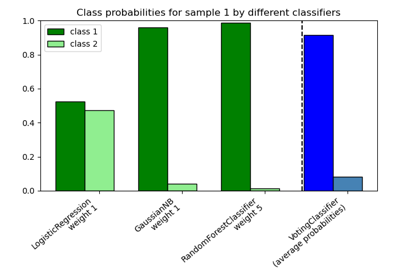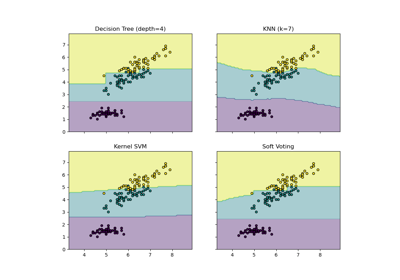sklearn.ensemble.VotingClassifier¶
- class sklearn.ensemble.VotingClassifier(estimators, *, voting='hard', weights=None, n_jobs=None, flatten_transform=True, verbose=False)[source]¶
Soft Voting/Majority Rule classifier for unfitted estimators.
Read more in the User Guide.
New in version 0.17.
- Parameters:
- estimatorslist of (str, estimator) tuples
Invoking the
fitmethod on theVotingClassifierwill fit clones of those original estimators that will be stored in the class attributeself.estimators_. An estimator can be set to'drop'usingset_params.Changed in version 0.21:
'drop'is accepted. Using None was deprecated in 0.22 and support was removed in 0.24.- voting{‘hard’, ‘soft’}, default=’hard’
If ‘hard’, uses predicted class labels for majority rule voting. Else if ‘soft’, predicts the class label based on the argmax of the sums of the predicted probabilities, which is recommended for an ensemble of well-calibrated classifiers.
- weightsarray-like of shape (n_classifiers,), default=None
Sequence of weights (
floatorint) to weight the occurrences of predicted class labels (hardvoting) or class probabilities before averaging (softvoting). Uses uniform weights ifNone.- n_jobsint, default=None
The number of jobs to run in parallel for
fit.Nonemeans 1 unless in ajoblib.parallel_backendcontext.-1means using all processors. See Glossary for more details.New in version 0.18.
- flatten_transformbool, default=True
Affects shape of transform output only when voting=’soft’ If voting=’soft’ and flatten_transform=True, transform method returns matrix with shape (n_samples, n_classifiers * n_classes). If flatten_transform=False, it returns (n_classifiers, n_samples, n_classes).
- verbosebool, default=False
If True, the time elapsed while fitting will be printed as it is completed.
New in version 0.23.
- Attributes:
- estimators_list of classifiers
The collection of fitted sub-estimators as defined in
estimatorsthat are not ‘drop’.- named_estimators_
Bunch Attribute to access any fitted sub-estimators by name.
New in version 0.20.
- le_
LabelEncoder Transformer used to encode the labels during fit and decode during prediction.
- classes_ndarray of shape (n_classes,)
The classes labels.
n_features_in_intNumber of features seen during fit.
- feature_names_in_ndarray of shape (
n_features_in_,) Names of features seen during fit. Only defined if the underlying estimators expose such an attribute when fit. .. versionadded:: 1.0
See also
VotingRegressorPrediction voting regressor.
Examples
>>> import numpy as np >>> from sklearn.linear_model import LogisticRegression >>> from sklearn.naive_bayes import GaussianNB >>> from sklearn.ensemble import RandomForestClassifier, VotingClassifier >>> clf1 = LogisticRegression(multi_class='multinomial', random_state=1) >>> clf2 = RandomForestClassifier(n_estimators=50, random_state=1) >>> clf3 = GaussianNB() >>> X = np.array([[-1, -1], [-2, -1], [-3, -2], [1, 1], [2, 1], [3, 2]]) >>> y = np.array([1, 1, 1, 2, 2, 2]) >>> eclf1 = VotingClassifier(estimators=[ ... ('lr', clf1), ('rf', clf2), ('gnb', clf3)], voting='hard') >>> eclf1 = eclf1.fit(X, y) >>> print(eclf1.predict(X)) [1 1 1 2 2 2] >>> np.array_equal(eclf1.named_estimators_.lr.predict(X), ... eclf1.named_estimators_['lr'].predict(X)) True >>> eclf2 = VotingClassifier(estimators=[ ... ('lr', clf1), ('rf', clf2), ('gnb', clf3)], ... voting='soft') >>> eclf2 = eclf2.fit(X, y) >>> print(eclf2.predict(X)) [1 1 1 2 2 2]
To drop an estimator,
set_paramscan be used to remove it. Here we dropped one of the estimators, resulting in 2 fitted estimators:>>> eclf2 = eclf2.set_params(lr='drop') >>> eclf2 = eclf2.fit(X, y) >>> len(eclf2.estimators_) 2
Setting
flatten_transform=Truewithvoting='soft'flattens output shape oftransform:>>> eclf3 = VotingClassifier(estimators=[ ... ('lr', clf1), ('rf', clf2), ('gnb', clf3)], ... voting='soft', weights=[2,1,1], ... flatten_transform=True) >>> eclf3 = eclf3.fit(X, y) >>> print(eclf3.predict(X)) [1 1 1 2 2 2] >>> print(eclf3.transform(X).shape) (6, 6)
Methods
fit(X, y[, sample_weight])Fit the estimators.
fit_transform(X[, y])Return class labels or probabilities for each estimator.
get_feature_names_out([input_features])Get output feature names for transformation.
get_params([deep])Get the parameters of an estimator from the ensemble.
predict(X)Predict class labels for X.
Compute probabilities of possible outcomes for samples in X.
score(X, y[, sample_weight])Return the mean accuracy on the given test data and labels.
set_params(**params)Set the parameters of an estimator from the ensemble.
transform(X)Return class labels or probabilities for X for each estimator.
- fit(X, y, sample_weight=None)[source]¶
Fit the estimators.
- Parameters:
- X{array-like, sparse matrix} of shape (n_samples, n_features)
Training vectors, where
n_samplesis the number of samples andn_featuresis the number of features.- yarray-like of shape (n_samples,)
Target values.
- sample_weightarray-like of shape (n_samples,), default=None
Sample weights. If None, then samples are equally weighted. Note that this is supported only if all underlying estimators support sample weights.
New in version 0.18.
- Returns:
- selfobject
Returns the instance itself.
- fit_transform(X, y=None, **fit_params)[source]¶
Return class labels or probabilities for each estimator.
Return predictions for X for each estimator.
- Parameters:
- X{array-like, sparse matrix, dataframe} of shape (n_samples, n_features)
Input samples.
- yndarray of shape (n_samples,), default=None
Target values (None for unsupervised transformations).
- **fit_paramsdict
Additional fit parameters.
- Returns:
- X_newndarray array of shape (n_samples, n_features_new)
Transformed array.
- get_feature_names_out(input_features=None)[source]¶
Get output feature names for transformation.
- Parameters:
- input_featuresarray-like of str or None, default=None
Not used, present here for API consistency by convention.
- Returns:
- feature_names_outndarray of str objects
Transformed feature names.
- get_params(deep=True)[source]¶
Get the parameters of an estimator from the ensemble.
Returns the parameters given in the constructor as well as the estimators contained within the
estimatorsparameter.- Parameters:
- deepbool, default=True
Setting it to True gets the various estimators and the parameters of the estimators as well.
- Returns:
- paramsdict
Parameter and estimator names mapped to their values or parameter names mapped to their values.
- predict(X)[source]¶
Predict class labels for X.
- Parameters:
- X{array-like, sparse matrix} of shape (n_samples, n_features)
The input samples.
- Returns:
- majarray-like of shape (n_samples,)
Predicted class labels.
- predict_proba(X)[source]¶
Compute probabilities of possible outcomes for samples in X.
- Parameters:
- X{array-like, sparse matrix} of shape (n_samples, n_features)
The input samples.
- Returns:
- avgarray-like of shape (n_samples, n_classes)
Weighted average probability for each class per sample.
- score(X, y, sample_weight=None)[source]¶
Return the mean accuracy on the given test data and labels.
In multi-label classification, this is the subset accuracy which is a harsh metric since you require for each sample that each label set be correctly predicted.
- Parameters:
- Xarray-like of shape (n_samples, n_features)
Test samples.
- yarray-like of shape (n_samples,) or (n_samples, n_outputs)
True labels for
X.- sample_weightarray-like of shape (n_samples,), default=None
Sample weights.
- Returns:
- scorefloat
Mean accuracy of
self.predict(X)wrt.y.
- set_params(**params)[source]¶
Set the parameters of an estimator from the ensemble.
Valid parameter keys can be listed with
get_params(). Note that you can directly set the parameters of the estimators contained inestimators.- Parameters:
- **paramskeyword arguments
Specific parameters using e.g.
set_params(parameter_name=new_value). In addition, to setting the parameters of the estimator, the individual estimator of the estimators can also be set, or can be removed by setting them to ‘drop’.
- Returns:
- selfobject
Estimator instance.
- transform(X)[source]¶
Return class labels or probabilities for X for each estimator.
- Parameters:
- X{array-like, sparse matrix} of shape (n_samples, n_features)
Training vectors, where
n_samplesis the number of samples andn_featuresis the number of features.
- Returns:
- probabilities_or_labels
- If
voting='soft'andflatten_transform=True: returns ndarray of shape (n_samples, n_classifiers * n_classes), being class probabilities calculated by each classifier.
- If
voting='soft' and `flatten_transform=False: ndarray of shape (n_classifiers, n_samples, n_classes)
- If
voting='hard': ndarray of shape (n_samples, n_classifiers), being class labels predicted by each classifier.
- If
Examples using sklearn.ensemble.VotingClassifier¶

Plot class probabilities calculated by the VotingClassifier

Plot the decision boundaries of a VotingClassifier
